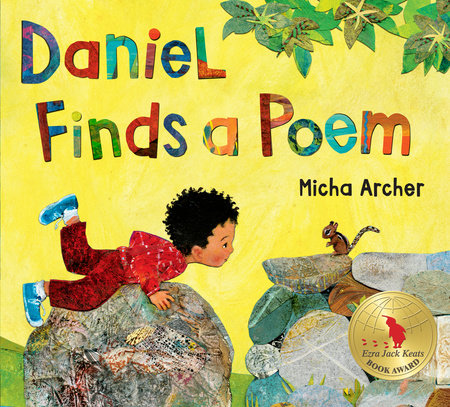Discovering the Concept of Poetry with Daniel Finds a Poem
by Micha Archer
Many young children are familiar with the word “poem” yet have a hard time conceptualizing what poetry truly is, or feel daunted by the idea of writing their own. There are strict rules for various types of poems, but the term “poetry” itself is broad and inclusive.
I like to think of poetry as painting a moment with words. Nursery rhymes are poems; lyrics for songs are poems too, and the rhyming and rhythm help listeners remember the words more easily.
Poems can be about anything:
good experiences,
bad ones,
feelings,
memories,
wishes, or
ideas.
They can —
tell stories,
rhyme,
not rhyme,
make shapes,
have rhythm,
sound pretty,
and be long
or short.
The poet must carefully choose their words to capture quickly and imaginatively whatever they want to say. When a poem works well we might think:
Aha, I see what you mean, or
I know that feeling! or
Wow, I never thought of it like that before.
In my picture book, Daniel Finds a Poem, a young boy named Daniel asks animals in the park what poetry is to them, discovering that the word “poetry” evokes thoughts of beauty and wellbeing for each animal. Individually, the animals’ answers offer words of practical advice for staying healthy and safe; when Daniel puts all of their answers together, they reveal a beautiful poem.
“To me, poetry is when morning dew glistens.”

Morning dew for Spider is one way she gets water to drink. The dew droplets on her web, each filled with a little bit of morning sun, are a magical sight. This makes Daniel stop for a while and notice the intricacies of how Spider’s web is made.
“Poetry?” she answers with a hop. “Poetry is a home with many windows in an old stone wall.”

Chipmunk needs a safe place for a home, somewhere to hide from dogs, cats, hawks, and owls. From the safety of the stone wall she can still see everything going on in the rest of the park. Rock walls are fun for Daniel to walk on, lie on, look at closely. They have varying surfaces — rough and smooth, lichen- and moss-covered, sparkling and warmed by the sun.
“I think poetry is a cool pool to dive into,” says Frog.
 Frog needs to keep her skin wet in order to breathe. A jump into a cool pool on a late summer day is refreshing! Daniel makes a boat for Frog out of things he finds around him, and he imagines what it might be like to sail that boat and jump off for a swim.
Frog needs to keep her skin wet in order to breathe. A jump into a cool pool on a late summer day is refreshing! Daniel makes a boat for Frog out of things he finds around him, and he imagines what it might be like to sail that boat and jump off for a swim.
“Hmmm,” Turtle says, “I think poetry is sun-warmed sand.”
 For Turtle, sun-warmed sand is a perfect place for her to lay her eggs. It feels good to sit in the sun with Daniel for a while and just watch and listen quietly.
For Turtle, sun-warmed sand is a perfect place for her to lay her eggs. It feels good to sit in the sun with Daniel for a while and just watch and listen quietly.
“Singing at twilight when the day is done? Indeed it is, Daniel.”
 Dusk is really morning for the Cricket; he wakes up when the day cools down and begins singing to find a mate. What a beautiful time of day for the Cricket to spend with someone like Daniel, sitting and watching the sunset sky change colors.
Dusk is really morning for the Cricket; he wakes up when the day cools down and begins singing to find a mate. What a beautiful time of day for the Cricket to spend with someone like Daniel, sitting and watching the sunset sky change colors.
One great way to help kids understand poetry is to read poems aloud together. Daniel Finds a Poem lends itself well as a read-aloud performance, with Daniel and the various animals he meets as different characters.
Throughout Daniel’s adventures, he encounters many discussion-worthy moments:
poetry,
nature,
pond life,
days of the week,
times of the day,
the five senses,
parks,
being outside,
curiosity,
habitats,
mammals and insects,
nocturnal and diurnal animals,
and community gathering.
After reading a poem together, you and your child might want to try creating your own poem with different animals of your choosing. Keep in mind that whatever the animal needs could also be something the child needs or enjoys doing as well.
Researching different animals’ food, homes, defenses, nests, and surroundings are ways for children to learn about animals that live right around them.
And just like that, they’ll realize they’ve found a poem.
Have you ever talked to your child about poems — or even written them together? Let us know in the comments below!

